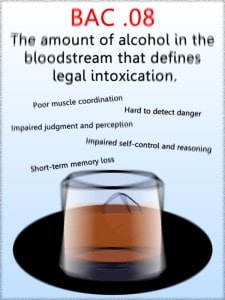 It seems like a pretty simple idea: lowering the BAC limit will reduce DUIs across the country. Right now, the national limit for a DUI or other drunk driving conviction is .08 percent. The NTSB recommends lowering that limit to .05 percent. M.A.D.D. doesn’t necessarily support this change, a surprise to many. So, what gives? Do we want a lower BAC limit for DUI offenders?
It seems like a pretty simple idea: lowering the BAC limit will reduce DUIs across the country. Right now, the national limit for a DUI or other drunk driving conviction is .08 percent. The NTSB recommends lowering that limit to .05 percent. M.A.D.D. doesn’t necessarily support this change, a surprise to many. So, what gives? Do we want a lower BAC limit for DUI offenders?
Yes… and no. Lowering the BAC limit will definitely put more drunk drivers in a courtroom. A lower BAC limit could also get more ignition interlock devices on vehicles, preventing subsequent drunk driving incidents. But, even the NTSB cannot confirm how many more drunk drivers will be “caught” under the new guideline (it is estimated that less than 10 percent of drunk driving fatalities fall between the .05 and .08 BAC levels). So, for a national effort that will require time, energy and money – is the juice worth the squeeze?
If you consider that even M.A.D.D. wants more focus on ignition interlock devices and other methods to eliminate drunk driving, there’s a lot to consider in the debate. Studies show that ignition interlock devices reduce repeat offenses by 67 percent or more, leaving little room for error in reducing drunk driving incidents.
Outside of legal issues, lowering the BAC limit starts with us – if we know we’re starting to feel that “buzz” it is on us to find a safe ride home. When we drink responsibly, we’re not concerned with the legality of our level of intoxication because we’re not breaking the law. We are not endangering others on the road, and we are ensuring that a DUI is never a fear we could have to face. Our BAC means a lot when we’re looking at those flashing blue lights in the rear view mirror, but when we know we’re taking the right steps to stay sober, that BAC factor is little more than a headline “buzz” word. It really is that simple.

Leave a Reply
You must be logged in to post a comment.